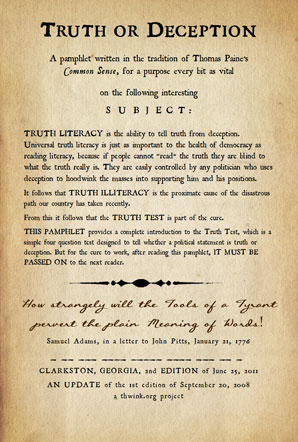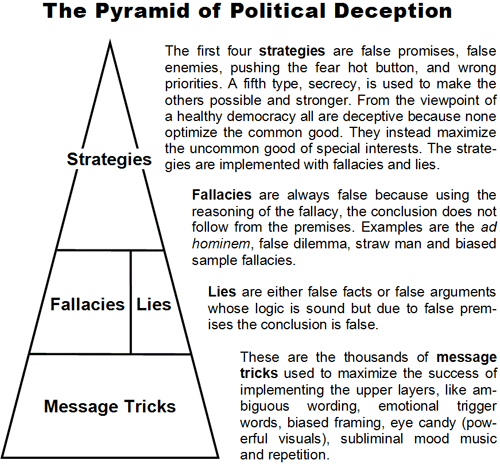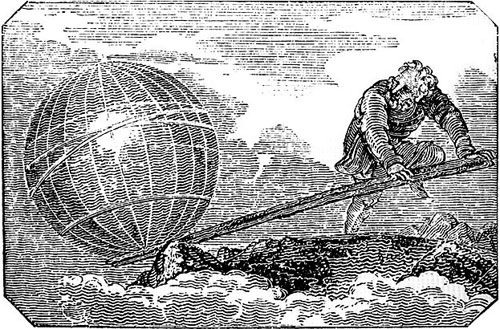
The Truth or Deception Pamphlet - First Nine Pages
 Here is the pamphlet itself.
Here is the pamphlet itself.
Below are the first nine pages, beginning with the cover:
Truth or Deception
A pamphlet written in the tradition of Thomas Paine's
Common Sense, for a purpose every bit as vitalon the following interesting
S U B J E C T :TRUTH LITERACY is the ability to tell truth from deception. Universal truth literacy is just as important to the health of democracy as reading literacy, because if people cannot “read” the truth they are blind to what the truth really is. They are easily controlled by any politician who uses deception to hoodwink the masses into supporting him and his positions.
It follows that TRUTH ILLITERACY is the proximate cause of the disastrous path our country has taken in the last eight years.
From this it follows that THE TRUTH TEST is part of the cure.
THIS PAMPHLET provides a complete introduction to the Truth Test, which is a simple four question test designed to tell whether a political statement is truth or deception. But for the cure to work, after reading this humble pamphlet, it must be passed on to the next reader.
How strangely will the Tools of a Tyrant
pervert the plain Meaning of Words!
Samuel Adams, in a letter to John Pitts, January 21, 1776CLARKSTON, GEORGIA
Third Edition ~ February 2, 20010On truth literacy and the survival of a nation
A nation cannot long endure if oppressed, whether by a mother country, a tyrant, a class, or any other group who puts their own interests first. Oppression is the act of using power to benefit one group at the expense of another. The identity of the oppressor is built by antagonism to the oppressed. In a democracy, oppression requires the consent of the oppressed.
Truth literacy is the ability to tell truth from deception. Universal truth literacy is just as important to the health of democracy as reading literacy, because if people cannot “read” the truth they are blind to what the truth really is. They are easily controlled by any politician who uses deception to hoodwink the masses into supporting him and his positions.
Political deception is an age old, world wide problem. Its success has led to more corruption, war, economic catastrophe and oppression than any other single cause. For example, how did Vladimir Lenin rise to power and consolidate his and the communist party’s iron grip after the Bolshevik Revolution? Some by force, but mostly by the fog of deception. It was he who gave the world this chilling quote:
“A lie repeated often enough becomes the truth.”
But if citizens can tell that lies are not the truth they don’t work, no matter how many times they may be repeated. In fact, once a person has been fully inoculated against deception, each further repetition of a bold lie only serves to drive them further away from the deceiving politician.
While political deception is a worldwide problem, this pamphlet is written for those living in a country where the problem has spun out of control. If Thomas Paine were alive and writing today, he might repeat his cry that “These are times that try men’s souls,” because in that country a new brand of politics has replaced reason and the common good with something else.
That nation was formerly the most prosperous and esteemed on the planet. But since the ascendency of a party that bases its power on the two most powerful special interest groups in the world, large for-profit corporations and the rich, that nation has stumbled badly.
While those special interests have profited immensely, on the average everyone else has suffered. Most people see their real incomes shrinking. They see their constitutional rights being taken away, drip by steady drip. They see minor issues like abortion, immigration, guns and gays rising to a fever pitch of prominence, while the issues that really matter go unattended. They see their country turning away from the constructive forces of cooperation to the destructive forces of unilateralism. From 2000 to 2008 they watched a record surplus turn into a record deficit and saw their President fabricate a war that has now killed between 151,000 and 1,033,000 people. Oppression stalks the country, draining away its life one more drop at a time.
And it’s all happened in the United States of America, the country that invented modern democracy, where such things should not be possible.
Piled on top of that enigma sits another. When the Great Recession hit the people threw off the oppressing party and voted in one that worked for the common good. But now only a year later in 2010, public opinion is turning against the party and administration that’s working for the common good, despite the fact this is totally unjustified. Obama and the Democrats didn’t cause the recession, or the high expense of two wars, or the deficit. But they are being successfully blamed for it. WHY IS THIS?
Because while you can’t fool all of the people all of the time, you can fool most of the people most of the time, with the right political deception.
But what if those people could no longer be fooled? If the majority of the people could see the truth they would rise up on Election Day, peacefully throw their oppressors out, and return their nation and the world it has partially destroyed to normality.
This has been done before, and we can do it again.
On January 10, 1776, Thomas Paine published the first edition of his 48 page pamphlet, Common Sense. Starting on that day, that nation’s people begin to see the truth. The first printing of 1,000 copies sold out in days. More printings followed. In a matter of weeks the people begin to arise from foggy slumber and ponder what to do. Later that year they took the strongest action possible to throw their oppressors out, when on July 4, 1776 their representatives signed the United States Declaration of Independence.
Common Sense did what this pamphlet attempts to do: it allowed an intelligent population to break free from the bonds of deception, by replacing illusion with reality. Common Sense explained, in simple terms everyone could follow, why the colonies had to wake up and break free from their mother country. Edmund Randolph, who later became Virginia’s seventh governor in 1786, wrote that “the public sentiment which a few weeks before shuddered at the tremendous obstacles, with which independence was environed, overleaped every barrier.” A reviewer in Connecticut noted “We were blind, but on reading these enlightening words the scales have fallen from our eyes.” Writing in a letter to a friend, a Bostonian said “Independence a year ago could not have been publickly [sic] mentioned with impunity ... Nothing else is now talked of, and I know not what can be done by Great Britain to prevent it.”
We can do it again, because the same preconditions exist.
Today, as then, the population senses something is intolerably wrong, but cannot unify behind a single course of action and a leader promoting that action. Powerful special interests (royalty and the aristocracy then, large corporations and the rich now) are exploiting and oppressing the population, but too many people are unable to see the situation for what it is and break free. The nation has followed a course of action for so long that most of its citizens are fervently attached to their current world view and ideology, and are resistant to change. A galaxy of confusing, conflicting, and often unfounded opinions exists, causing the people to be unable to determine what to do.
What would happen if we could cut through that fog of confusion and inability to change as swiftly as Common Sense did over 200 years ago?
This can be done with another pamphlet, one based on the Truth Test.
The Truth Test: a way to tell truth from deception
The Truth Test is a simple test designed to tell whether a political statement is true, false, or just plain nonsense. This allows voters to tell reality from illusion and political benevolence from oppression. They can then answer the question every democracy depends on: Is this truth or deception?
The Truth Test works for people who have an open mind and are earnestly seeking to make decisions based on a reasonable approximation of the truth. It tends to not work for those highly committed to a particular ideology or candidate, because they usually rationalize away input that conflicts with their viewpoint and accept the rest. Fortunately this leaves swing voters and those who are not highly committed.
The Truth Test is not perfect. As an element of critical thinking it takes effort to apply and requires judgment calls. But once practiced for awhile, it should allow you to sail through most attempts to influence your vote in little longer than the time it takes to watch or read them.
The test consists of these four questions:
1. What is the argument?
2. Are any common patterns of deception present?
3. Are the premises true, complete, and relevant?
4. Does each conclusion follow from its premises?In politics about 80% of false arguments are based on well known, easily spotted patterns of deception, like creating a false enemy, pushing the fear hot button, the false dilemma fallacy, and the ever popular ad hominem attack. Thus only the first two questions are needed in most cases. This makes the test fast and easy to apply.
Let’s take a look at the test, one question at a time.
Step 1. What is the argument?
The purpose of an argument is to establish or strengthen belief. An argument consists of one or more reasons (also known as premises) leading to a conclusion. The reasons and conclusion can be stated or, if obvious or well known, implied. If an argument contains no reasons or a conclusion, it’s not an argument. It’s nonsense.
But it may be such clever, appealing nonsense that it works, as in:
“Support our troops” or “Vote for me in November”
Neither argument contains a premise and a conclusion. Both are unsupported conclusions, because no reason is given as to why you should support the troops or why you should vote for me. Because they are not an argument but attempt to sway your belief, they are nonsense. Such candidates are trying to manipulate you with empty slogans and sheer hogwash. Their crude arguments demonstrate that their real intention is to do whatever they want—after they have tricked you into supporting them.
Do more statements make an argument better? Not if it’s still nonsense, as in:
“Our country is a great place. It takes courage to win a war. I was a war hero. Vote for me in November.”
There are still no clear premises or conclusion. There are too many ways to interpret the statement. It’s not a clear argument but a soggy hodgepodge of related snippets, designed to worm their way into your brain and get you to vote for the candidate in November. Even though it’s not an argument, if it’s repeated often enough it works. Imagine the above snippets sprinkled in a dozen speeches, fifty ads, and a hundred lame talk show appearances by those supporting a candidate. If the other side doesn’t do something more effective, that candidate will win. The human mind cannot resist such continual onslaughts of infective deception, unless it has been properly inoculated.
Notice what’s happening here. For the Truth Test to work you have to put up your guard and not accept arguments without consciously evaluating them. This is more than skepticism. It’s like taking The Smart Voter Pledge: “I will no longer be a pawn of political manipulation. From this day forward I can’t be fooled, because from now on I’m going to apply the Truth Test to every attempt to persuade me to support a politician or position. If I don’t have the time to apply it then I’m going to ignore the appeal.” At first this will be difficult or slow. But with practice it will become a swift reliable habit.
It’s impossible to evaluate an argument until you know what the argument is. Consider this popular appeal:
“A vote for me is a vote for a better country.”
This could be restated as “If you vote for me then that will make this a better country.” Now that we know what the argument is, we can see that “If you vote for me” is the premise and “that will make this a better country” is the conclusion.
But is the argument true or false? No reasons are given for why “a vote for me” will make this a better country. Thus this argument and all those like it are false. But it contains great emotional appeal, because we would all like a better country. That’s why we see arguments like this over and over. They work. But they won’t work anymore if voters can see them for what they are and ignore them, or better yet, come to an even more productive conclusion: that politicians who rely on emotional arguments are not to be trusted.
An argument has three parts: one or more premises, a conclusion, and the reasoning that allows the conclusion to logically follow from the premises. Complex arguments can be so long they require intermediate conclusions, which become premises for further conclusions. The diagram illustrates the three parts all arguments must have.
Homo sapiens means “knowing human” because our greatest tool is reason. Without it we would be little different from the other primates and civilization would not exist.
Lately that difference is in jeopardy, because in the nation in trouble the average voter is no longer able to use mankind’s greatest tool to pick the best candidate. Instead, citizens base their choices mostly on emotion and the insidious effect of deliberate lies. If this trend and its consequences continue then all is lost, eventually including civilization itself, due to the unavoidable effects of environmental, economic, and social unsustainability. But if we can turn this trend around we could start electing leaders who would see these problems as their highest priority and solve them in the interest of the common good, instead of continuing to elect leaders bent on satisfying the goals of their special interests.
Since this is somewhat important, let’s turn our attention to the reasoning part of arguments, and see if perhaps we can improve things a little.
“The wise are instructed by reason; ordinary minds by experience; the stupid, by necessity; and brutes by instinct.” ~ Marcus Cicero, orator and statesman of ancient Rome, 106BC to 43BC.
Step 2. Are any common patterns of deception present?
Deception makes falsehoods appear true, by misleading the normal processes of reason. The art of political deception is so complex that to make sense of it we have classified the common patterns of political deception into four categories and organized them into a tool for thinking at a higher level. This gives us a hierarchy of deception techniques, which we call:
At the bottom layer of the pyramid sit the thousands of message tricks that tricksters use to put the final wrapping on their glittering packages of deception. There are so many of these one quickly gets lost in trying to understand even the most common. But if we can spot deception by working at the higher layers then there is no need to work at the bottom layer. Learning a handful of the most common tricks can, however, make it easier to sniff out false appeals.
The middle layer contains the fallacies and lies used to implement deception strategies. Fallacies are false due to the unsound reasoning used. There are hundreds of types of fallacies but less than a dozen common ones. This makes it possible for you to be able to instantly spot most fallacies.
There are two types of lies: false facts and false arguments whose logic is sound (no fallacy is used) but due to false premises the conclusion is false. Root premises are themselves facts, so all lies are based on false facts.
Lies are not nearly as easy to spot as fallacies because they often require expert knowledge or access to data to prove or disprove the facts. The average person does not have this knowledge or data. We are thus dependent on politicians to tell us the truth.
But too many don’t, so we’re stuck. Unless we can develop a surefire way to spot lies and fallacies we will forever be at the mercy of unscrupulous politicians. We will forever be expendable pawns in their ruthless the-end-justifies-the-means struggle for power and more power, and their game of more and more rewards for their special interests, at our expense. So what can we do?The answer lies at the top of the pyramid. If we can spot deception strategies in play, then we can assume that the rest of the pyramid is being used to carry them out. So we don’t have to work much at the bottom or the middle layers. We can work mostly at the top, where our efforts will have the greatest leverage because we will be working at the strategic instead of the tactical level.
Let’s walk through each of the four sections of the pyramid, starting at the top.
* * *
“Give me a lever long enough, and a place to stand, and I can move the earth.” ~ Archimedes, 287 to 212 BC, was a Greek mathematician, physicist, engineer, and astronomer. Archimedes invented the Law of Levers.
For the rest, read the Truth or Deception Pamphlet.



























